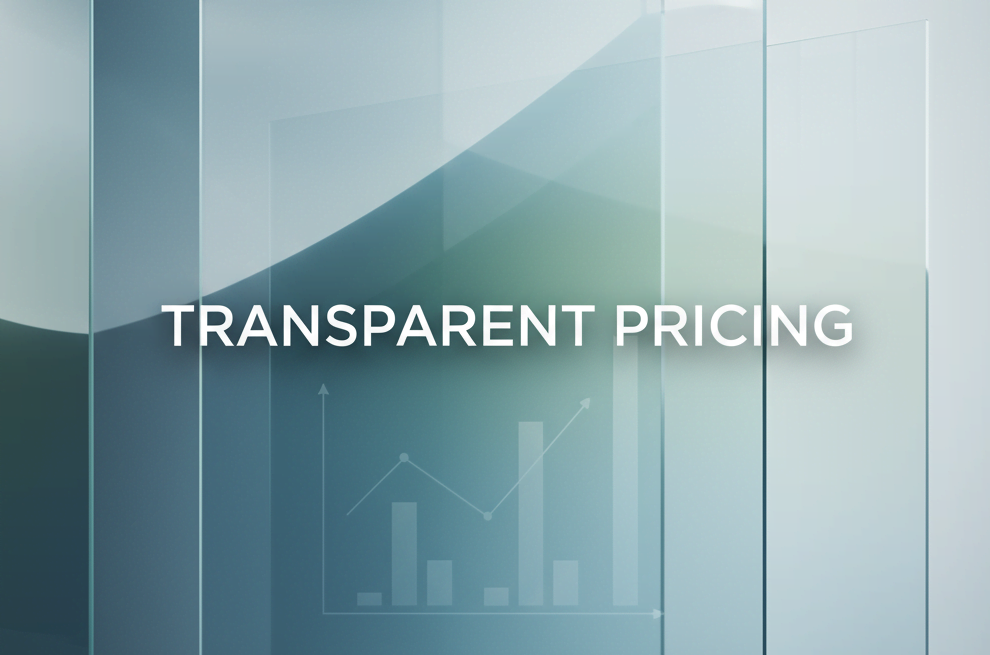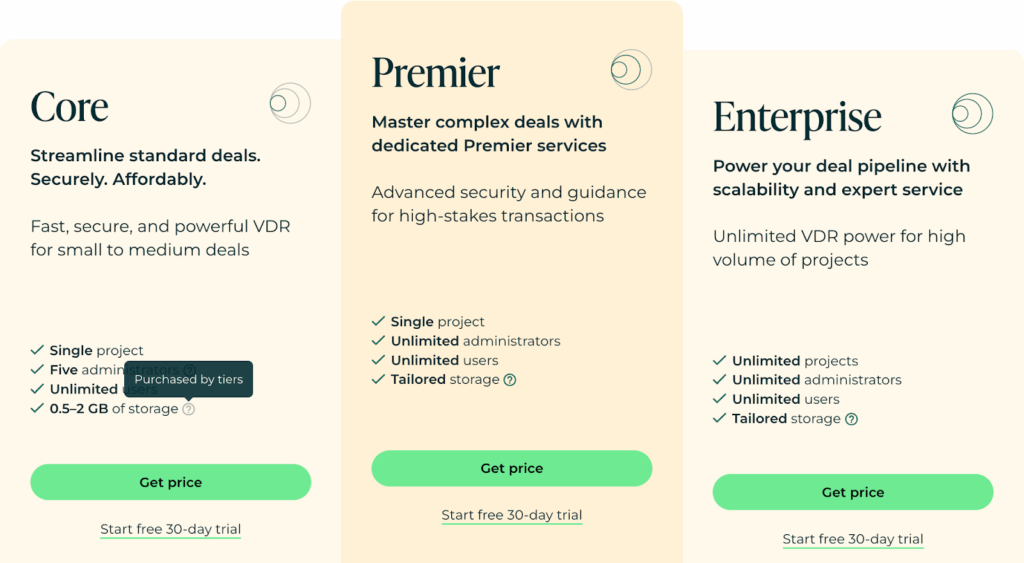When you open Amazon to make a purchase, you can see the total price, including shipping costs and taxes, allowing you to know what you pay for. This clarity builds customer loyalty and ensures you understand the full cost before making a decision. Similarly, when selecting a virtual data room provider implementing price transparency, you avoid unexpected expenses.
To put it simply, software pricing can make or break your deal. So, what is behind the right pricing decisions?

Understanding transparent VDR pricing
Business software users increasingly seek clarity and predictability in their budgets, especially when handling mergers and acquisitions, legal cases, financial audits, and other complex deals. Therefore, reliable virtual data room providers prioritize transparent pricing models to help clients avoid unexpected costs, simplify financial planning, and build lasting partnerships based on trust and clarity.
What are the main characteristics of transparent data room pricing?
- Upfront cost structure. Transparent VDR providers set a fixed monthly or annual fee based on the anticipated number of users or a straightforward package with defined services.
- No hidden fees. Transparent pricing eliminates hidden fees, such as charges for specific file types, additional users, or unexpected data volume increases.
- Simplified data volume and storage costs. Some pricing models may rely on data volume and storage-based costs and cause unanticipated expenses. Transparent models simplify this aspect by offering straightforward plans that eliminate data overage fees or provide clear data limits upfront.
If a data room provider follows all these transparency policies, clients can confidently focus on their projects without worrying about hidden fees.
What are the models of transparent VDR pricing?
Here is how the most transparent pricing strategies work:
1. Flat-rate pricing
A flat-rate pricing strategy involves a one-time fee that covers data room usage for a specific project or period. With this model, businesses benefit from a predictable cost structure without additional fees. Furthermore, some providers offer unlimited data storage and user access, which can be highly cost-effective for projects with high data volumes.
| Pros | Cons |
| ✔️Predictable budgeting for clients | ✖️Clients may pay for more capacity than they use |
| ✔️No data overage charges | ✖️If a project decreases, clients may still be locked into the same rate |
| ✔️Simplifies billing with an all-inclusive fee |
Flat-rate pricing is best for businesses that want cost certainty and unlimited data room usage without the hassle of monitoring data limits or incurring overage fees.
2. Subscription-based pricing
The subscription-based model charges clients monthly or annually. Unlike flat-rate models, typically project-bound, subscription-based virtual data rooms offer ongoing access to the platform. Usually, clients can adjust features, storage space, and user access levels as required. This flexibility makes subscriptions valuable for scaling data operations without interruption.
| Pros | Cons |
| ✔️Monthly or annual fees allow for steady financial planning | ✖️Even if usage fluctuates, costs remain the same each billing period |
| ✔️Easy to upgrade or downgrade service levels as project needs change | ✖️Some subscriptions may include caps on data or users |
Subscription-based pricing is best for clients with ongoing data room needs or long-term projects that require stable data access, such as recurring financial audits or regular compliance tasks.

Onehub — Cloud Storage & Virtual Data Room Pricing and Cost
Subscription-based pricing example
3. Tiered pricing
Providers that use tiered pricing offer multiple plan levels, or “tiers,” with each higher tier including additional features and capabilities. Clients choose a tier based on their needs, paying a set rate per month or year for the selected level. Basic tiers typically provide core features like document storage and basic security, while higher ones may include analytics, strengthened security, and specialized customer support.
| Pros | Cons |
| ✔️Clients can choose the tier that best matches their usage needs and budget | ✖️Clients need to estimate data and usage needs accurately |
| ✔️Ability to add or reduce tiers as project needs evolve | ✖️Clients may pay for a longer period than needed if the project concludes ahead of schedule |
Tiered pricing is best for clients with specific, predictable data requirements or those managing short-term projects, like due diligence for mid-sized acquisitions.

Ideals Virtual Data Room Pricing & Plans
Tiered pricing example
All these virtual data room pricing models are transparent, with each approach offering a clear structure to avoid hidden costs. However, choosing the best fit depends on a company’s project needs, budget, and flexibility. Later, we will guide you in selecting the ideal solution for your needs!
Transparent pricing importance in VDRs
Here is how you can benefit from the providers who implement price transparency:
1. No hidden fees
Price transparency reduces the risk of surprise expenses, which is common in volume-based or per-page pricing models. With clear information about what is and isn’t included, businesses can avoid sudden cost spikes, which may strain financial resources and impact project timelines.
2. Predictable billing
Transparent pricing models allow businesses to plan accurately for current and future expenses. When pricing structures clearly outline costs associated with data storage, access levels, and user limits, companies can anticipate total project costs more effectively. It is critical for projects with strict budgets, where unexpected fees could otherwise lead to budget overruns.
3. Easy adjustments and scalability
Transparent pricing also facilitates easier adjustments. Whether scaling up for a larger transaction or reducing features after peak periods, companies can adjust services without extra fees. Moreover, this flexibility ensures that organizations only pay for what they need and optimize costs without compromising essential features.
Choosing a provider with transparent pricing allows you to manage projects without financial concerns and stay on track with your budget, which gives you a competitive edge in other aspects of a project or transaction.
What are other pricing strategies data room providers use?
Some data room providers use pricing models with unexpected costs, making it challenging for clients to stick to a predetermined budget. They include the following:
- Volume-based pricing. Here, the amount of data transferred or stored determines the service cost. Although this can be affordable initially, significant increases in data volume can result in increased fees.
- Per-page pricing. This model charges based on the number of pages uploaded or accessed. Companies may consider this cost-effective for smaller projects. However, large-scale transactions often involve many pages, leading to significant pitfalls of per-page VDR pricing models.
- Pay-per-user pricing. Providers using this strategy charge for each user who needs data room access. The software can quickly become expensive if a project requires a large team or a growing number of users.
Next, we will compare pricing strategies to help you understand the different impacts transparent and less transparent models can have on specific business deals.
What is the competitive advantage of transparent providers over in key business deals
Here is how data room pricing models can make or break your deal:
| Deal | Flat-rate, subscription, tiered pricing | Volume-based, per page, per user pricing |
| M&A | These models help companies predict the cost throughout the transaction, providing clear financial planning for due diligence and post-transaction management. | Unexpected costs can arise, especially with large amounts of sensitive data or multiple users accessing a data room, resulting in a budget overrun and financial strain. |
| Financial audits | These models work well for ongoing audits, where the usage volume is predictable, and the scope of data is manageable. Thus, businesses get financial certainty throughout the process. | As audit data grows or more auditors need access, costs can spiral unexpectedly. It can create challenges for firms working with tight audit budgets. |
| Legal cases | Transparency offers flexibility with a set number of data storage or user limits, with the ability to upgrade when necessary without additional fees, making it suitable for lengthy legal proceedings. | If more attorneys or legal experts need access, costs quickly increase. So, these models can make long cases unpredictable and difficult to budget. |
📝Calculations!
A company is engaging in an M&A transaction that requires storing thousands of pages of other confidential documents in a data room for six months.
Pay-per-page pricing model
- Estimated number of pages: 20,000.
- Cost per page: $0.50.
- Total cost for 20,000 pages: 20,000 × $0.50 = $10,000.
As the due diligence process progresses, more documents are added, bringing the total to 35,000 pages. This results in an additional $7,500 in fees.
- New number of pages: 35,000.
- New cost per page: 35,000 × $0.50 = $17,500.
Over the 6 months, the total cost would be:
- Initial cost: $10,000.
- Additional cost: $7,500.
- Total cost for the entire deal: $17,500.
Flat-rate pricing model
Flat rate: $500 per month (for unlimited access and data storage)
Duration: 6 months
Total cost: $500 x 6 = $3,000 for the entire duration of the project
So, to avoid surprises during lengthy and complex projects, select a virtual data room provider prioritizing price transparency. But how can you ensure you are selecting the right one?
How to choose the right VDR provider?
Here are the top critical questions you should ask a provider to ensure transparency and clarity in pricing:
- What is included in the pricing? Seek a clear breakdown of what the quoted price covers. Does it include document storage, user access, and support services? Are there add-ons that influence pricing decisions of this provider?
- Are there any hidden fees in VDRs? Ask specifically about fees that might arise unexpectedly, such as per-page/per-user charges or costs for accessing certain types of data.
- What are the data limits, and what are the charges for exceeding them? If you work with large amounts of information, you should clarify how the provider handles overages and what the associated costs are.
- What support services do you offer, and at what cost? Ask if support is included in the pricing or if additional fees apply for 24/7 access.
Transparency in pricing helps teams manage costs and promotes increased customer satisfaction, as clients feel confident and informed. Therefore, you should prioritize transparency when selecting a data room provider to ensure clear financial expectations and avoid unexpected costs.
Like Amazon displays the total price, including shipping fees, before checkout—leaving no surprises at the final stage and caring about consumer trust—choosing a VDR provider with clear pricing ensures you will not encounter hidden costs.